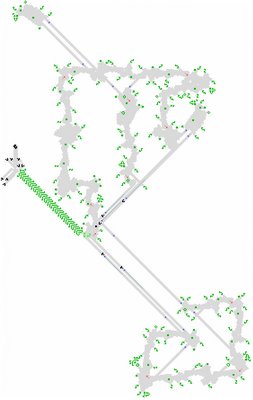This version of the receiver can process signals separated by 2175 or more generations. The incoming signal interacts with a small constellation of still lifes at the receiver end of the 2c/3 track (two blocks and an eater, shown in light green in the picture). With the assistance of a few catalysts, the constellation collapses cleanly into an R-pentomino, which is then guided onto a Herschel track.
The path of the active signal is shown in gray the image below; the direction of travel is indicated by the red arrows. Gliders from the output Herschel (short blue arrows) are used to create two more Herschels; the Herschels are then routed to various Herschel-to-glider converters, which produce five gliders in two salvos (long blue arrows). Four of these gliders collide to rebuild the original constellation. (The first glider just removes an extra block left by the conversion of the receiver's initial output R-pentomino to a Herschel.)
2c/3 signal receiver: Dave Greene, 6 February 2005

No comments:
Post a Comment